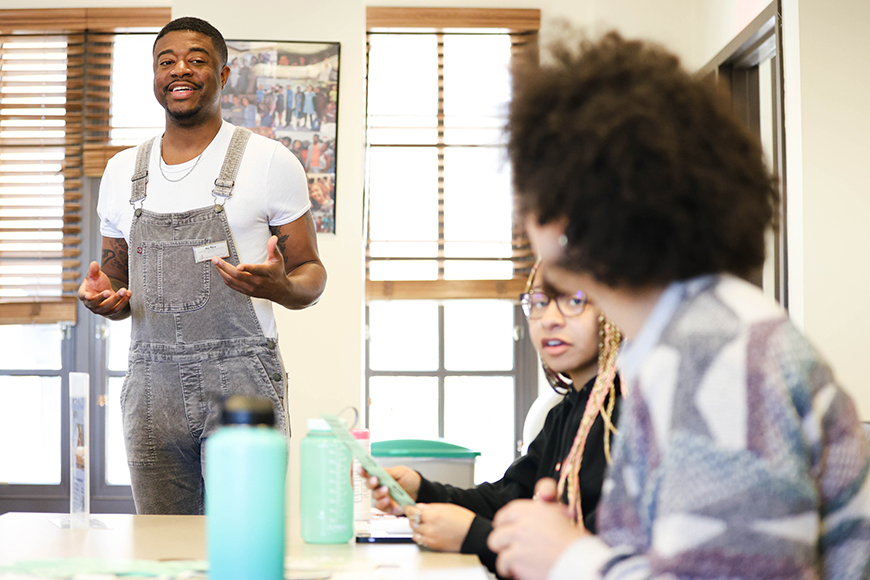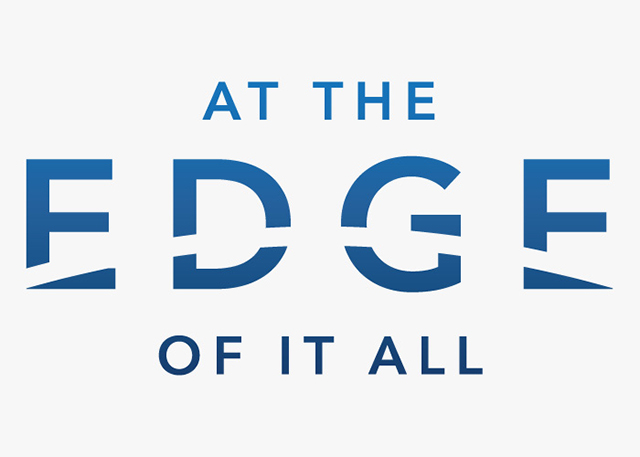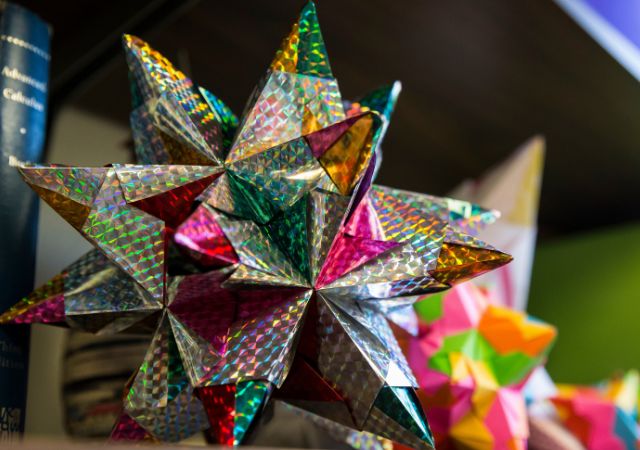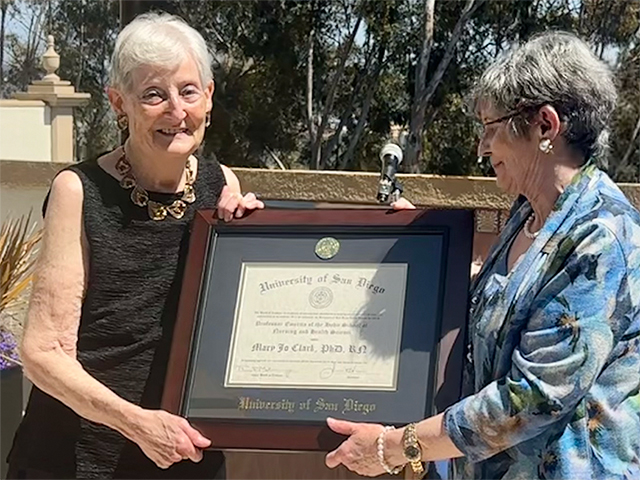Q&A with Jay Rice, Director, Black Student Resource Commons
 USD Black Student Resource Center Director Jay Rice talks to students on Thursday, March 2, 2023. (Photo by Matthew Piechalak)
USD Black Student Resource Center Director Jay Rice talks to students on Thursday, March 2, 2023. (Photo by Matthew Piechalak)As the new director of the Black Student Resource Commons (BSRC), Jay Rice is ready to hit the ground running. “This is very specific work,” he says. “For me, serving Black students ultimately makes me happy. And the institution benefits because of [increased] recruitment and retention of these students.”
Rice joined USD in December, after serving as assistant director for the Black Resource Center at the University of California San Diego. Prior to that, he worked in student housing for several years until he realized that his work gravitated toward Black student experiences, including advising Black students and working to create unique leadership opportunities for them.
“I realized that those were the things that sustained me — it moved from being just a job to there being passion behind it. I realized that I wanted to focus the work on a day-to-day basis to be about Black students. I’m passionate about helping Black students develop socially, academically and grow their identities.”
The Black Student Resource Commons opened in 2013 and focuses on providing all aspects of support for Black students. It’s a space for advice and advocacy; a place for programs, events and services focused on the needs of the Black community at USD; and a place to explore personal identity and shine a positive light on Black culture.
How would you describe USD’s Black Student Resource Commons?
The BSRC is about the holistic development of all students but with specific emphasis on Black students in both undergraduate and graduate programs. We provide services that allow our students to develop academically and socially, and to explore their identity, which is extremely important, especially in understanding that we do exist at a predominately white institution. The commons provides a physical space for students to be able to study and to relax and take a break. It’s an environment for intentional dialogue — one that really centers on Black experiences.
Briefly talk about some of the resources the commons provides?
We have academic, personal and financial advising services. Currently, we are partnering with various campus individuals to do outreach to students who potentially didn’t do as well last semester. We want to make sure we assist in setting students up for success, so we reach out to see how we can support those students and help them get back on sound footing.
We are also doing a lot of new things: In reference to identity development, we are doing more to explore the intersections of Black identity through our “Black And” series. We are partnering with various individuals on campus to explore what it means to be, for instance, Black and LGBTQ+ or Black and female-identifying.
What is an existing program you are excited about growing?
Our Black Summer Immersion Program is one that is really about helping Black students acclimate early to the university. We recognize that sometimes our underrepresented student populations don’t always have as much experience coming into an institution that allows for a sound and seamless transition. It’s about providing assistance. This summer we’ll have a cohort of about 22-40 students. Currently, it’s only a weeklong program, but I would love to make it longer and merge it with the Student Support Services' Summer Bridge to allow students to get credit while fully immersing and engaging with our campus partners so they understand how to navigate our resources to really set them up for success.
The BSRC currently has a peer mentor program for first-year Black students. Describe the importance of peer mentorship and how you’d like to expand the program.
Peer-to-peer mentorship is very important — there are a lot of conversations that are just better served for students to have with their peers, because they’re able to provide a level of perspective that you might not get from the professional staff on campus. I think many of us can relate to being students and getting advice from adults versus getting advice from the peers that are currently living and going through the same experiences that you are. It adds a layer of validity to the advice.
I would love to see a program that allows access to continuous peer-to-peer mentorship, whether they are first year students or senior students looking to receive a graduate mentor. We are trying to see how our mentorship program can tap into the students that went through the program to serve as future mentors.
How important is it to have a dedicated resource for Black students at USD?
Sincerely, it’s paramount. Something that I don’t think we acknowledge often enough is that identity is such an important part of our lives. It doesn’t often come up in curriculum but impacts the ways in which we learn and the ways we navigate the very spaces we are in. It’s important to have that student-facing component, because it allows for students to engage with us in ways that feel comfortable for them and meet them where they are in reference to their identity development. It allows for dialogue to take place that is centered on those experiences and explore what it really means to be them right now and what it means to be a Black student at USD.
Having a space that really centers Black student experiences also helps with inclusion, because it allows our students to see themselves reflected in the infrastructure of our institution which is extremely important. It also ensures that advocacy is taking place because there are also people behind the scenes reminding the campus environment that the responsibility to these students isn’t just on the BSRC, but all of our students. There is a lot that goes into the significance of centers such as the BSRC. Part of it is the physical space and part of it is having the staff to engage behind the scenes in various layers of pursuits of equity and advocacy for the students that we are serving.
Did you have a resource like this when you were in college?
No, I wish! Right at the time I was graduating from graduate school, we actually had just gotten a multicultural center. I am appreciative of the expansion of spaces like that just to understand that college campuses are very diverse environments and we want our students in a general sense to understand and see themselves reflected. I like how specific we have gotten with our commons. It would have been nice to see myself outside of the Black student organizations because when I was a student, there weren’t very many Black professors at my institution and there were a lot of racially-charged things that happened. I went to my campus at a time when there was a blackface party and there wasn’t even necessarily space to discuss that. I think it’s really fortunate that not just our institution, but institutions nationally, are creating more identity-based centers.
Can you share an experience at the BSRC that has validated the work you are doing at USD?
I was in conversations with a few students when I started and one of the questions I had for them was asking if there is a Black graduate student association at USD. There used to be, but it hadn’t been running for years. We talked about it one day and within the next week, those students literally had an executive board and they were putting in the paperwork to become a registered student organization. They are now getting traction in terms of membership.
To go from one conversation to seeing them as an up-and-running student organization that I am currently serving as the advisor for was a moment that validated why I do this work. Even talking about it brings me so much joy, because it shows how quickly the students mobilized to help themselves when we’re there to support them. It is something I’m really excited about and a testament to why I do what I do.
What is the future of the BSRC?
The first is expansion. Right now, I am the only permanent full-time staff member but there has been community feedback that we need another full-time professional. Expansion of staff means we can expand our resources. Along with that, right now we are really focused on reengaging the community and trying to serve in a capacity that allows us to interweave with the community. I think returning to campus fully and navigating the pandemic, things feel a little disjointed right now as we all try to get our footing and adjust to what it means to be back on campus. I really see us serving as a bridge for the Black community to engage, and a bridge for faculty, staff and students alike to come together.
Another focus is really just reengaging our Black graduate populations. We want to make sure that we are providing resources that are beneficial to our undergraduate and graduate populations that also potentially allow us to leverage those students that are in those advanced degree programs to see how we can capitalize on the fact that a lot of them are doing amazing research.
Finally, I want to continue finding new partnerships on our campus and I want to build relationships with parents and families.
Is there anything else you’d like to add?
We are here in the Student Life Pavilion in room 410. Come visit us — we are a vibe! It’s a great environment. I would also say to staff and faculty, the students want you all to come in because we want the commons to not only serve as a resource and space for the students, but we are looking at what it means to have that cohesive community and our faculty and staff at all levels are a big part of that.
— Story and photos by Matthew Piechalak



